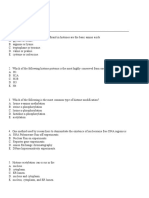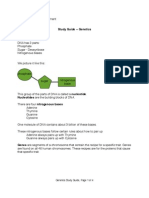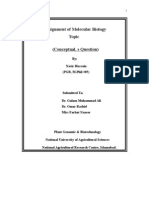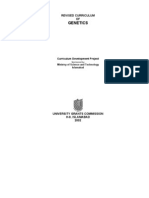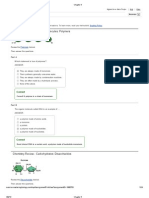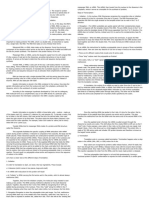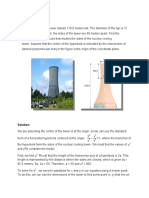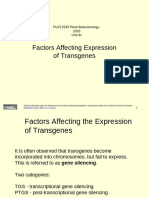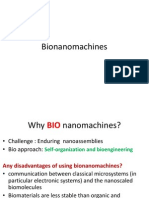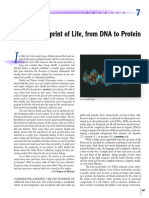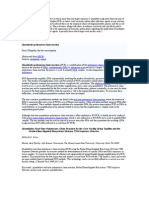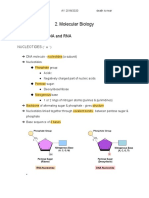0 ratings0% found this document useful (0 votes)
62 viewsTranscription and Translation Narrative
Transcription and Translation Narrative
Uploaded by
Bridget Anne Benitez1. Transcription and translation are the processes that create polypeptides and proteins from DNA.
2. Transcription involves RNA polymerase copying DNA to make mRNA. Translation involves ribosomes using mRNA to assemble amino acids into proteins.
3. The three main types of RNA are mRNA, tRNA, and rRNA. mRNA carries genetic information from DNA to ribosomes. tRNA transports amino acids to ribosomes. rRNA assists ribosomes in protein production.
Copyright:
© All Rights Reserved
Available Formats
Download as DOCX, PDF, TXT or read online from Scribd
Transcription and Translation Narrative
Transcription and Translation Narrative
Uploaded by
Bridget Anne Benitez0 ratings0% found this document useful (0 votes)
62 views3 pages1. Transcription and translation are the processes that create polypeptides and proteins from DNA.
2. Transcription involves RNA polymerase copying DNA to make mRNA. Translation involves ribosomes using mRNA to assemble amino acids into proteins.
3. The three main types of RNA are mRNA, tRNA, and rRNA. mRNA carries genetic information from DNA to ribosomes. tRNA transports amino acids to ribosomes. rRNA assists ribosomes in protein production.
Copyright
© © All Rights Reserved
Available Formats
DOCX, PDF, TXT or read online from Scribd
Share this document
Did you find this document useful?
Is this content inappropriate?
1. Transcription and translation are the processes that create polypeptides and proteins from DNA.
2. Transcription involves RNA polymerase copying DNA to make mRNA. Translation involves ribosomes using mRNA to assemble amino acids into proteins.
3. The three main types of RNA are mRNA, tRNA, and rRNA. mRNA carries genetic information from DNA to ribosomes. tRNA transports amino acids to ribosomes. rRNA assists ribosomes in protein production.
Copyright:
© All Rights Reserved
Available Formats
Download as DOCX, PDF, TXT or read online from Scribd
Download as docx, pdf, or txt
0 ratings0% found this document useful (0 votes)
62 views3 pagesTranscription and Translation Narrative
Transcription and Translation Narrative
Uploaded by
Bridget Anne Benitez1. Transcription and translation are the processes that create polypeptides and proteins from DNA.
2. Transcription involves RNA polymerase copying DNA to make mRNA. Translation involves ribosomes using mRNA to assemble amino acids into proteins.
3. The three main types of RNA are mRNA, tRNA, and rRNA. mRNA carries genetic information from DNA to ribosomes. tRNA transports amino acids to ribosomes. rRNA assists ribosomes in protein production.
Copyright:
© All Rights Reserved
Available Formats
Download as DOCX, PDF, TXT or read online from Scribd
Download as docx, pdf, or txt
You are on page 1of 3
TRANSCRIPTION AND TRANSLATION - Contains codons
- RNA molecules is exactly identical to
Transcription- synthesis of mRNA by a DNA
the sense strand (ORIGINAL DNA
template by RNA polymerase.
MOLECULE 5’-3’ STRAND) except for
Translation- synthesis of polypeptides on the the presence of U instead of T.
ribosomes.
3’-5’ anti-sense or template strand
- Used in transcription
WHAT IS THE PURPOSE OF TRANSCRIPTION - mRNA and sense strand are
AND TRANSLATION? compliment to anti sense
- contains anti-codons
These processes is significant for the creation
of polypeptides that forms proteins.
CODON- 3 base sequences of mRNA
ANTI-CODON- 3 base sequences of tRNA
3 Main Types of RNA:
1. mRNA- found on cytoplasm and nucleus START CODON- AUG (METHIONINE)
STOP CODON- UAA, UAG, UGA
- delivers genetic information from
DNA to ribosomes.
3. TERMINATION
2. tRNA - found on cytoplasm and nucleus Occurs when RNA polymerase crosses the
transcription terminator, it is a hairpin
- delivers amino acid to ribosomes to
loop structure causing RNA polymerase
build a polypeptides or proteins.
and mRNA strand to dissociate in the
3. rRNA- found on nucleus and ribosomes DNA.
- combines with proteins to make
ribosomes. TRANSLATION PROCESS
RIBOSOMES or the free ribosomes of the
cytoplasm is the site of translation. It has
TRANSCRIPTION PROCESS 2 parts the large part which is called the
NUCLEUS is the site of transcription since it is 60s subunits and the smaller part which is
where you find the DNA. the 40s subunits. 40s subunits is where
initiation happens while elongation
1. INITIATION happens in 60s subunits. 60s subunits
RNA polymerase binds to a promoter region. have also 2 major sites/parts namely the P
This signals DNA to unwind. site and the A site.
2. ELONGATION P site- holds the peptide chain
RNA polymerase reads the unwounded DNA A site- accepts tRNA
stand and builds mRNA molecules on the
sense strand using complementary base pairs.
1. INITIATION
5’-3’ sense or coding strand
- Not used as a template for
transcription, used ONLY AS A
DIRECTION FOR TRANSCRIPTION
5’ to 3’ of mRNA binds in the small 40s
subunits of ribosomes along with methionyl
tRNA. AUG a starting codon must be
recognized in order for translation to begin.
2. ELONGATION ASSIGNMENT: ANSWER THE FOLLOWING ON
A ¼ SHEET OF PAPER.
Methionyl tRNA occupies P site while
aminoacyl tRNA with an anti-codon occupies FRONT OF THE PAPER (Transcription)
the A site. (Remember that methionyl tRNA is
together with mRNA, met tRNA serves as a 1. Synthesis of mRNA is in what direction?
vehicle for mRNA to be transported inside the 2. Transcription begins when RNA polymerase
ribosomes). The enzyme peptidyl-transferase binds to?
forms peptide bonds between Methionine
(methionine or AUG a starting codon is found 3. When RNA polymerase reaches a sequence
on the mRNA present in the P site together of nucleotides on the DNA called the
with met tRNA) and aminoacyl tRNA thus transcription terminator, it causes the RNA
synthesizing the whole strand. polymerase and mRNA to dissociate from
DNA.
3. TERMINATION
TRUE OR FALSE?
One of the 3 stop codons enters the A site.
(The A site is the one who recognizes the stop 4. RNA polymerase copies the template
codon because basically mRNA that contains strand of DNA making single-stranded mRNA
the codons is found in the P site). No tRNA complementary to the DNA template.
binds to these codons so the peptides and TRUE OR FALSE?
tRNA in the P site becomes hydrolyzed
releasing the polypeptides in the cytoplasm. 5. The complimentary messenger RNA strand
that would be synthesized from DNA base
The small and large subunits of ribosomes sequence CTAG would be?
dissociate for the next translation process.
6. The synthesis of messenger RNA is called
translation.
Genetic Code- sequence of DNA or RNA that TRUE OR FALSE?
determines the amino acid sequence of
proteins. 7. Synthesis of a new strand of mRNA is in the
3’ to 5’ direction.
TRUE OR FALSE?
8-10. ENUMERATE THE THREE TYPES OF RNA
WITH COMPLETE MEANING. EXAMPLE mRNA:
what do you mean by m? M….. RNA.
BACK OF THE PAPER (Translation)
1. Give the codons that translates for aspartic
acid
2. If mRNA contains the base sequence
CUGACUAGGUCCGGA
a. give the amino acid sequence of the
polypeptide
b. give the base sequence of the DNA anti-
sense strand from which the mRNA was
transcribed
3. If mRNA contains the base sequence
ACUAAC give the base sequence of the DNA
sense strand.
4. Give the amino acids present in the DNA
strand below
DNA: ACGTTACGGATTACAGTCCCAAACTAC
You might also like
- Signature Assignment 3 EnzymesDocument4 pagesSignature Assignment 3 Enzymesapi-709406220No ratings yet
- Protein Synthesis Transcription and Translation Distance LearningDocument10 pagesProtein Synthesis Transcription and Translation Distance LearningjaneyzhouNo ratings yet
- Killing Chloroplasts:: Herbicides Targeting PhotosynthesisDocument7 pagesKilling Chloroplasts:: Herbicides Targeting PhotosynthesisAhmed MohsenNo ratings yet
- Dr. Peter John M.Phil, PHD Assistant ProfessorDocument25 pagesDr. Peter John M.Phil, PHD Assistant ProfessorMehak ToorNo ratings yet
- IGA 10e SM Chapter 09Document18 pagesIGA 10e SM Chapter 09Muneeb Arshad100% (1)
- Physical Education - Jive DanceDocument6 pagesPhysical Education - Jive DanceBridget Anne BenitezNo ratings yet
- Chapter 17 - Transcription and TranslationDocument14 pagesChapter 17 - Transcription and TranslationAdonias NiyurukundoNo ratings yet
- Transcription and TranslationDocument35 pagesTranscription and TranslationMing mingNo ratings yet
- Eoc Review AnswersDocument10 pagesEoc Review Answersapi-267855902No ratings yet
- Practice - DNA, RNA, Gene Expression (Solutions)Document4 pagesPractice - DNA, RNA, Gene Expression (Solutions)SophieNo ratings yet
- Pretest 10Document5 pagesPretest 10Ghazi DallyNo ratings yet
- Quiz 9 14 Answers PDFDocument2 pagesQuiz 9 14 Answers PDFюрий локтионовNo ratings yet
- DNA Replication and Protein Synthesis Review Practice MC CPDocument5 pagesDNA Replication and Protein Synthesis Review Practice MC CPBernie Cabang PringaseNo ratings yet
- CH 13Document12 pagesCH 13김예진No ratings yet
- Transcription and Translation Simulation WorksheetDocument4 pagesTranscription and Translation Simulation WorksheetDonna NNo ratings yet
- Transcription: RNA Polymerases and General Transcription FactorsDocument77 pagesTranscription: RNA Polymerases and General Transcription FactorsmluluNo ratings yet
- Mutations WSDocument3 pagesMutations WSNixoniaNo ratings yet
- Rea Lec 9 DNA ReplicationDocument89 pagesRea Lec 9 DNA ReplicationnedmzadNo ratings yet
- Mutations WorksheetDocument3 pagesMutations Worksheetapi-293001217No ratings yet
- EOC Test 2 PDFDocument30 pagesEOC Test 2 PDFShaquan GabrielNo ratings yet
- From Gene To ProteinDocument16 pagesFrom Gene To ProteinPatricia NerNo ratings yet
- CH 12 Online Study GuideDocument7 pagesCH 12 Online Study Guideюрий локтионовNo ratings yet
- Chapter Fourteen: RNA Molecules and RNA Processing: Comprehension Questions Section 14.1Document11 pagesChapter Fourteen: RNA Molecules and RNA Processing: Comprehension Questions Section 14.1Qayyum LatipNo ratings yet
- Chapter 13 RNA Test NAME Abdullah Alabdullah CLASS 9A DATEDocument7 pagesChapter 13 RNA Test NAME Abdullah Alabdullah CLASS 9A DATEAbdullah AlabdullahNo ratings yet
- In-Depth Steps Towards Nucleic Acid and Protein SynthesisDocument21 pagesIn-Depth Steps Towards Nucleic Acid and Protein SynthesisGbenga AjaniNo ratings yet
- Dna ExtractionDocument2 pagesDna Extractionapi-358984084No ratings yet
- Module-1: Genomics and Proteomics NotesDocument8 pagesModule-1: Genomics and Proteomics NotesNishtha KhannaNo ratings yet
- Genetics Study GuideDocument4 pagesGenetics Study Guidegmanb5100% (2)
- Genetics Review Questions KeyDocument37 pagesGenetics Review Questions KeyRyan Christian PatriarcaNo ratings yet
- DNA - Student NotesDocument23 pagesDNA - Student NotesCola ChauNo ratings yet
- Assignment of Molecular BiologyDocument4 pagesAssignment of Molecular BiologyNasir Hussain FarazNo ratings yet
- Dna and Rna Structure Worksheet - EddyDocument3 pagesDna and Rna Structure Worksheet - Eddyapi-429499161No ratings yet
- Rotein Ynthesis: Big PictureDocument3 pagesRotein Ynthesis: Big PicturehomamunfatNo ratings yet
- 2012 Bio 93 Final Exam Lecture D Version B KEYDocument11 pages2012 Bio 93 Final Exam Lecture D Version B KEYHyds HshsNo ratings yet
- Genetics: Revised Curriculum OFDocument44 pagesGenetics: Revised Curriculum OFAzzura Najmie Fajriyah Tamalate0% (1)
- Transposable Genetic ElementDocument60 pagesTransposable Genetic ElementabimubNo ratings yet
- Genetic CodeDocument16 pagesGenetic CodeSivagami Satish kumarNo ratings yet
- Rna and TranscriptionDocument46 pagesRna and TranscriptionReyana BaderNo ratings yet
- Organization of DNADocument31 pagesOrganization of DNAoyehello23No ratings yet
- Genome Organization - 2020Document26 pagesGenome Organization - 2020Bagus Arya MahartaNo ratings yet
- H2 Biology - Notes On Organisation and Control of Prokaryotic and Eukaryotic GenomesDocument15 pagesH2 Biology - Notes On Organisation and Control of Prokaryotic and Eukaryotic GenomesSefLRho100% (5)
- Transcription and Translation WorksheetDocument2 pagesTranscription and Translation WorksheetMonkey D. DragonNo ratings yet
- Molecular GeneticsDocument18 pagesMolecular GeneticsJeremy SellersNo ratings yet
- Name - Date - Period - Mutations WorksheetDocument4 pagesName - Date - Period - Mutations WorksheetEric CalderónNo ratings yet
- 1001 Vocabulary Amp Spelling QuestionsDocument142 pages1001 Vocabulary Amp Spelling QuestionsAdvik NagarajanNo ratings yet
- IGA 10e SM Chapter 08Document12 pagesIGA 10e SM Chapter 08Muneeb ArshadNo ratings yet
- Chapter 5-Large BiomoleculesDocument24 pagesChapter 5-Large Biomoleculesprehealthhelp100% (4)
- PlasmidsDocument14 pagesPlasmidsMagesh RamasamyNo ratings yet
- Voyeurism in Cortazar's Continuidad de Los ParquesDocument10 pagesVoyeurism in Cortazar's Continuidad de Los Parquesnavarros100% (1)
- EOC BookletDocument33 pagesEOC BookletHalden LinNo ratings yet
- Central DogmaDocument4 pagesCentral DogmaRodriguez MiaNo ratings yet
- DR Okunowo Wahab's Introductory Molecular Biology Lecture Note IIDocument39 pagesDR Okunowo Wahab's Introductory Molecular Biology Lecture Note IImodelprof100% (2)
- Alan's Bio NotesDocument19 pagesAlan's Bio Notesluongc4100% (1)
- Unit 5 - Dna ReplicationDocument55 pagesUnit 5 - Dna Replicationapi-262235970100% (1)
- Unit 4 Cell Division and Cell Communication UnitDocument6 pagesUnit 4 Cell Division and Cell Communication Unitapi-237676607No ratings yet
- Studyguide AnswerkeyDocument23 pagesStudyguide Answerkeyapi-237676607No ratings yet
- DNA SequencingDocument30 pagesDNA Sequencingah9426237No ratings yet
- Transcription Translations HandoutDocument13 pagesTranscription Translations HandoutMedina Zahic100% (1)
- DNA RAN Prot Syn Web PracticeDocument11 pagesDNA RAN Prot Syn Web PracticeTimothy MacdonaldNo ratings yet
- Genetics Practice Problems PDFDocument9 pagesGenetics Practice Problems PDFanaphade5No ratings yet
- Protein SynthesisDocument2 pagesProtein SynthesisEverly Joy JingcoNo ratings yet
- EntrepreneurshipDocument2 pagesEntrepreneurshipBridget Anne BenitezNo ratings yet
- Empowerment Technologies - Lesson 1Document4 pagesEmpowerment Technologies - Lesson 1Bridget Anne BenitezNo ratings yet
- Project IN ScienceDocument25 pagesProject IN ScienceBridget Anne BenitezNo ratings yet
- Tephra and Ballistic ProjectilesDocument4 pagesTephra and Ballistic ProjectilesBridget Anne Benitez100% (1)
- Practical Research - TitlesDocument18 pagesPractical Research - TitlesBridget Anne BenitezNo ratings yet
- Simple InterestDocument13 pagesSimple InterestBridget Anne BenitezNo ratings yet
- Psychology - Several Theories and Research Results Related To Attraction and LikingDocument2 pagesPsychology - Several Theories and Research Results Related To Attraction and LikingBridget Anne BenitezNo ratings yet
- Freedom of Choice ResearchDocument15 pagesFreedom of Choice ResearchBridget Anne BenitezNo ratings yet
- Pe Written ReportDocument4 pagesPe Written ReportBridget Anne BenitezNo ratings yet
- Psychology - Attachment and AttractionDocument2 pagesPsychology - Attachment and AttractionBridget Anne BenitezNo ratings yet
- Parts of Sewing Machine Under The BedDocument1 pageParts of Sewing Machine Under The BedBridget Anne BenitezNo ratings yet
- Eudoxus of CnidusDocument3 pagesEudoxus of CnidusBridget Anne BenitezNo ratings yet
- Biaxial BendingDocument13 pagesBiaxial BendingBridget Anne BenitezNo ratings yet
- Transmitted Infections (Stis) - A Few Barrier Methods (Spermicide, Condom, and Sponge) Can BeDocument7 pagesTransmitted Infections (Stis) - A Few Barrier Methods (Spermicide, Condom, and Sponge) Can BeBridget Anne BenitezNo ratings yet
- Calculus - Hyperbola ProblemDocument2 pagesCalculus - Hyperbola ProblemBridget Anne BenitezNo ratings yet
- Regular NounsDocument17 pagesRegular NounsBridget Anne BenitezNo ratings yet
- As If It's Your Last: BlackpinkDocument17 pagesAs If It's Your Last: BlackpinkBridget Anne BenitezNo ratings yet
- Factors Affecting Expression of Transgenes: PLNT2530 Plant Biotechnology 2020 Unit 8cDocument7 pagesFactors Affecting Expression of Transgenes: PLNT2530 Plant Biotechnology 2020 Unit 8cSwati JainNo ratings yet
- BIO G12 Unit 3 Short NotesDocument12 pagesBIO G12 Unit 3 Short NotesAmanuel AyalewNo ratings yet
- Kerala University s8 Syllabus 2008 SchemeDocument29 pagesKerala University s8 Syllabus 2008 SchemeJijo PJNo ratings yet
- 12th Chap 12 BoardDocument3 pages12th Chap 12 BoardVraj PatelNo ratings yet
- Course of Veterinary Virology (Vetm 3075)Document94 pagesCourse of Veterinary Virology (Vetm 3075)Mampise DepyeNo ratings yet
- Serial Cloner HistoryDocument8 pagesSerial Cloner Historypinsam02No ratings yet
- Research Paper On Hepatitis BDocument20 pagesResearch Paper On Hepatitis Bjamaica_maglinteNo ratings yet
- Virus Structure and ReplicationDocument42 pagesVirus Structure and Replicationtummalapalli venkateswara rao100% (2)
- Nano Bio MachinesDocument19 pagesNano Bio MachinesStephen MooreNo ratings yet
- BiologyDocument24 pagesBiologyTom KiloitNo ratings yet
- Notes On Medical Virology What You Really Need To KnowDocument37 pagesNotes On Medical Virology What You Really Need To KnowMilyas100% (3)
- MSC Zoology KUKDocument73 pagesMSC Zoology KUKcutechikititaNo ratings yet
- Quantitative Polymerase Chain ReactionDocument14 pagesQuantitative Polymerase Chain ReactionnavkirNo ratings yet
- Michael L Riordan: Antisense Oligonucleotide Therapeutics and Genetic Targeting Book Chapter in Discoveries in Antisense Nucleic Acids 1989Document21 pagesMichael L Riordan: Antisense Oligonucleotide Therapeutics and Genetic Targeting Book Chapter in Discoveries in Antisense Nucleic Acids 1989OpenSquareCommonsNo ratings yet
- TranscriptionDocument72 pagesTranscriptionMurthy MandalikaNo ratings yet
- General MicrobiologyDocument68 pagesGeneral MicrobiologySupriya SharmaNo ratings yet
- Biology Notes - 2. Molecular BiologyDocument31 pagesBiology Notes - 2. Molecular BiologyKhansa Shafa LuthfiyaNo ratings yet
- Acellular Microbes PPT Feb. 2024Document61 pagesAcellular Microbes PPT Feb. 202421-54405No ratings yet
- Virus MnemonicDocument2 pagesVirus MnemonicTatum CheneyNo ratings yet
- Viral Replication MCQsDocument3 pagesViral Replication MCQsjehangir khanNo ratings yet
- Mission siRNA - Better siRNA Design, Better RNAi PerformanceDocument12 pagesMission siRNA - Better siRNA Design, Better RNAi PerformanceSigma-Aldrich100% (3)
- Micro 2 NotesDocument59 pagesMicro 2 Notesსალომე მუმლაძე “Slay” TMANo ratings yet
- (Advances in Parasitology 76) Louis M. Weiss and Herbert B. Tanowitz (Eds.) - Chagas Disease, Part B-Academic Press, Elsevier (2011)Document283 pages(Advances in Parasitology 76) Louis M. Weiss and Herbert B. Tanowitz (Eds.) - Chagas Disease, Part B-Academic Press, Elsevier (2011)Stoian GoranovNo ratings yet
- Hairpin RNA-Mediated Strategies For Silencing of Tomato Leaf Curl Virus AC1 and AC4 Genes For Effective Resistance in PlantsDocument10 pagesHairpin RNA-Mediated Strategies For Silencing of Tomato Leaf Curl Virus AC1 and AC4 Genes For Effective Resistance in Plantschuck212No ratings yet
- Test Bank For Molecular Biology of The Cell 5th Edition Bruce AlbertsDocument5 pagesTest Bank For Molecular Biology of The Cell 5th Edition Bruce AlbertsJames Jones100% (6)
- Target Identification and ValidationDocument21 pagesTarget Identification and ValidationManuel Christopher MontesclarosNo ratings yet
- Viruses - For XDocument40 pagesViruses - For XsepuluhtigaNo ratings yet
- CYTOGENETICS005Document22 pagesCYTOGENETICS005MICHAEL JOHN AGUILARNo ratings yet
- Gene SilencingDocument18 pagesGene SilencingNAMRA RASHEEDNo ratings yet
- DMT of MNDDocument39 pagesDMT of MNDthelegend 2022No ratings yet













